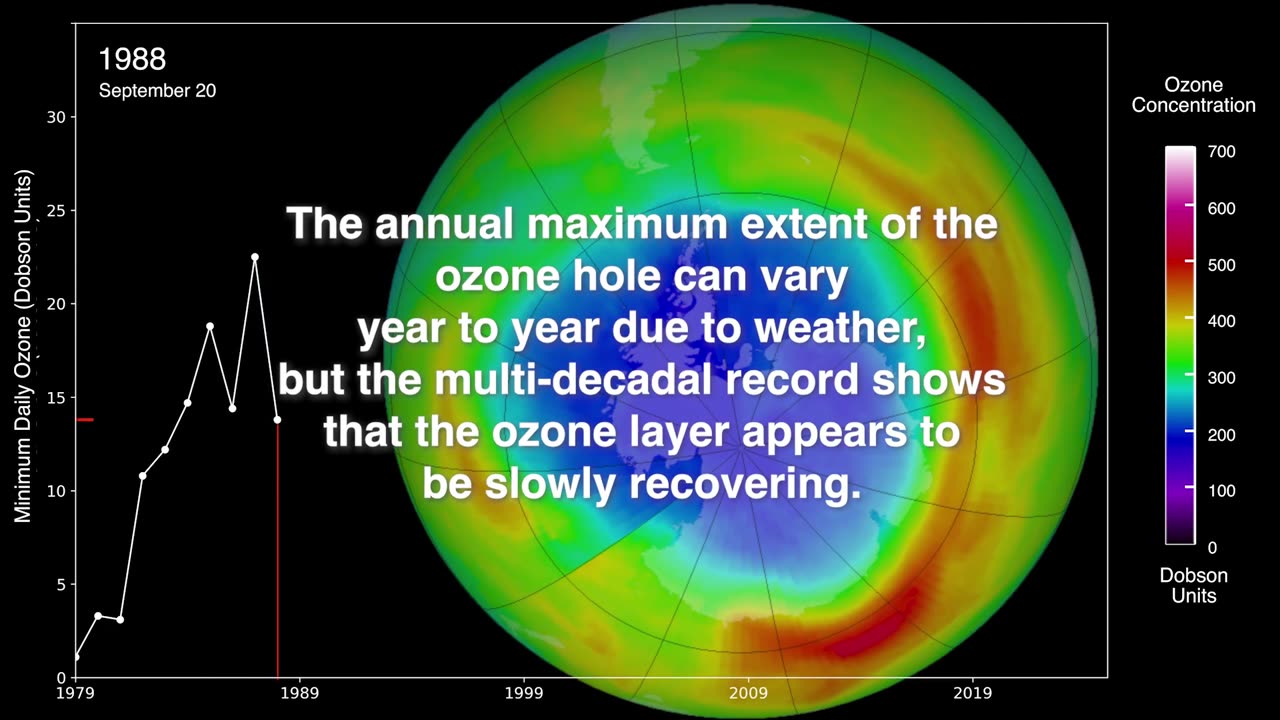Premium Only Content

NASA, NOAA 2024 Ozone Hole Update
This year, the ozone hole over Antarctica reached its annual maximum extent on September 28th, 2024, with an area of 8.5 million square miles (22.4 square million kilometers.)
The hole, which is actually a region of depleted ozone, was the 20th smallest since scientists began recording the ozone hole in 1979. The average size of the ozone hole between September and October this year was the 7th-smallest since the Montreal Protocol began to take effect.
Universal Music Production: “What Was Reported As Is”
Credit: NASA's Goddard Space Flight Center
Kathleen Gaeta (GSFC AMA): Lead Producer
Paul Newman (NASA GSFC): Lead Scientist
Amy Moran (NASA GSFC): Lead Visualizer
James Riordon (NASA GSFC): Writer
This video can be freely shared and downloaded at https://svs.gsfc.nasa.gov/14711 . While the video in its entirety can be shared without permission, the music and some individual imagery may have been obtained through permission and may not be excised or remixed in other products. For more information on NASA’s media guidelines, visit https://nasa.gov/multimedia/guidelines.
Transcript:
0:00
This year, the ozone hole over Antarctica reached its annual maximum extent on September 28th, 2024,
0:04
With an area of 8.5 million square miles (22.4 square million kilometers).
0:08
0:12
0:16
The hole, which is actually a region of depleted ozone, was the 20th smallest since scientists began recording the ozone hole in 1979.
0:20
0:24
The average size of the ozone hole between September and October this year was the 7th-smallest since the Montreal Protocol began to take effect.
0:28
0:32
The annual maximum extent of the ozone hole can vary year to year due to weather, but the multi-decadal record shows that the ozone layer appears to be slowly recovering.
0:36
0:40
“The weakening we’ve seen in the last two decades shows that international efforts that curbed ozone-destroying chemicals are working.” -Paul Newman, Chief Scientist for Earth Sciences at NASA Goddard
0:44
0:48
NASA and NOAA researchers continue to observe ozone through instruments aboard NASA’s Aura satellite, NOAA-20 satellites, and a joint NASA and NOAA satellite called Suomi-NPP.
0:52
0:56
NASA
-
 18:31
18:31
Nikko Ortiz
21 hours agoKaren You Need A Shower...
18.5K14 -
 1:09:52
1:09:52
VapinGamers
1 hour agoTools of the Trade - EP11 Highs and Lows of Streaming with Gothix - !rumbot !music
35 -
 LIVE
LIVE
SOLTEKGG
2 hours agoARC RADIDERS "First Month-Anniversary on Rumble"
141 watching -
 2:14:09
2:14:09
LFA TV
20 hours agoRUMBLE RUNDOWN WEEK 6 with JEREMY HERRELL AND SHAWN FARASH 11.15.25 9AM
99.6K7 -
 1:44:16
1:44:16
HotZone
4 hours agoLive: The Hidden Crisis in US Special Ops: What They’re Not Telling You About Women in Combat
1.46K7 -
 LIVE
LIVE
Athlete & Artist Show
18 hours agoBombastic Bets & Games w/ Team Canada Veteran!
86 watching -
 53:13
53:13
X22 Report
3 hours agoMr & Mrs X - It All Revolves Around Marxism, Think Political Correctness, Midterms Are Safe - EP 16
54.1K11 -
 LIVE
LIVE
I_Came_With_Fire_Podcast
9 hours agoThe Right's Drift into Neo-Marxism & America's Populist Crossroads
177 watching -
 LIVE
LIVE
Amarok_X
2 hours ago🟢LIVE 24 HR STREAM? | ARC RAIDERS TO START | OPERATION 100 FOLLOWERS | USAF VET
57 watching -
 LIVE
LIVE
Pepkilla
2 hours agoDay 2 of Camo Grinding Black Ops 7 ~ Until My Brain Rots
81 watching